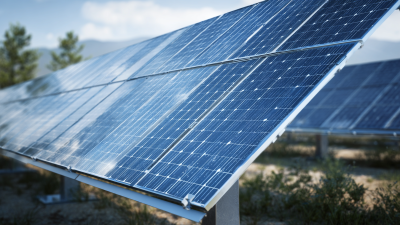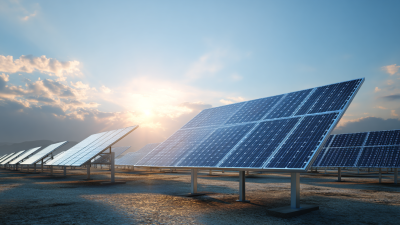7 Best Solar Systems Innovations Transforming Global Energy Markets
In recent years, the energy landscape has undergone a remarkable transformation, driven by innovative advancements in solar systems technology. As the world grapples with the challenges of climate change and the need for sustainable energy solutions, the evolution of solar systems has emerged as a beacon of hope. This blog will explore seven of the best innovations in solar systems that are not only reshaping how we harness solar energy but also influencing global energy markets. From cutting-edge photovoltaic materials to smart grid integrations, these advancements are paving the way for increased efficiency, accessibility, and sustainability. Join us as we delve into the fascinating world of solar systems and uncover how these innovations are positioned to revolutionize energy consumption and production across the globe.

Emerging Trends in Solar Technology: Key Innovations Shaping the Future
The solar energy landscape is constantly evolving, driven by emerging trends in technology that are reshaping the global energy market. Key innovations such as high-efficiency photovoltaic (PV) panels are on the forefront, allowing for greater energy conversion and higher outputs from smaller surface areas. These advancements are not just about enhancing efficiency; they also contribute to lower costs, making solar energy more accessible to a wider audience. As we move towards 2025, the momentum for clean energy investments, particularly in solar and energy storage, will only continue to build, reflecting a collective push towards sustainability.

Tips for embracing solar technology include staying informed about the latest innovations and considering energy-efficient systems that integrate seamlessly into existing infrastructures. Additionally, exploring smart solar solutions that utilize AI and machine learning can optimize energy use, reducing wasted resources. As these technologies advance, they will play a crucial role in powering homes and businesses while contributing to a greener future. Adopting these innovations not only cuts energy costs but also significantly reduces carbon footprints, aligning personal or corporate goals with wider environmental objectives.
Energy Storage Breakthroughs: Enhancing Solar Efficiency and Reliability
The landscape of solar energy is rapidly evolving, driven by groundbreaking innovations in energy storage that are enhancing solar efficiency and reliability. One of the most significant developments is the emergence of advanced lithium-ion batteries, which have dramatically improved the capacity and lifespan of energy storage systems. This progression allows for the seamless integration of solar power into the grid, enabling households and businesses to store excess energy generated during sunny days for use when the sun isn't shining. By boosting the availability of renewable energy, these storage solutions contribute to a more stable and resilient power supply.

Smart Solar Grids: The Role of AI in Decentralized Energy Distribution
The integration of artificial intelligence (AI) into smart solar grids is revolutionizing the way energy is distributed and consumed. Traditional energy systems often face challenges related to inefficiency and centralized control, which can lead to power outages and waste. However, with AI-driven smart grids, energy distribution becomes more resilient and responsive to real-time demand. By leveraging algorithms that analyze consumer behavior and environmental factors, these systems ensure optimal energy allocation and minimize losses during transmission.
Moreover, decentralized energy distribution empowered by AI facilitates greater consumer engagement and energy independence. Homeowners can generate their own solar energy, and AI systems can intelligently manage the consumption and distribution of this energy within local networks. For instance, when a neighborhood collectively produces excess solar power, AI can help redistribute this surplus to nearby areas in need, fostering energy sharing and reducing reliance on traditional utility providers. This innovative approach not only enhances grid stability but also promotes sustainable energy practices, ultimately leading to a greener, more self-sufficient energy landscape.
7 Best Solar Systems Innovations Transforming Global Energy Markets - Smart Solar Grids: The Role of AI in Decentralized Energy Distribution
| Innovation | Description | Impact on Energy Market | AI Role |
|---|---|---|---|
| Smart Meters | Devices that record energy consumption in real-time. | Promotes energy efficiency and demand-response strategies. | Analyzes consumption patterns for optimization. |
| Decentralized Energy Systems | Local energy generation using renewables. | Reduces reliance on centralized power plants. | Facilitates peer-to-peer energy trading. |
| Grid Energy Storage | Systems that store excess energy for later use. | Balances supply and demand, improves reliability. | Predicts peak usage times for charging. |
| Microgrid Technology | Localized grids that can operate independently. | Enhances resilience during outages. | Optimizes energy distribution based on real-time data. |
| Blockchain Integration | Secure transactions for energy trades. | Increases transparency and trust in energy exchanges. | Enables automated trading processes. |
| AI-Powered Predictive Analytics | Forecasting energy production and consumption. | Improves resource allocation and planning. | Utilizes machine learning to enhance accuracy. |
| Virtual Power Plants | Aggregating multiple decentralized energy sources. | Acts as a single power plant for market bidding. | Coordinates and schedules diverse energy resources. |
Bifacial Solar Panels: Maximizing Energy Capture with Innovative Designs
Bifacial solar panels are revolutionizing the solar energy landscape by harnessing sunlight from both sides of the panel. Unlike traditional solar panels, which only capture direct sunlight on one side, bifacial panels utilize innovative designs that significantly increase energy capture. This dual-sided approach allows for greater efficiency, as the panels can absorb reflected light from the ground and surrounding surfaces, effectively maximizing their energy output.
The technology behind bifacial solar panels has evolved rapidly, with advancements in materials and mounting systems contributing to their performance. These panels not only provide higher energy yields but also demonstrate improved durability against harsh weather conditions. Their ability to generate more electricity can lead to reduced overall system costs and a quicker return on investment for solar energy projects. As energy markets continue to transition towards sustainable solutions, bifacial solar panels stand out as a key innovation driving this transformation in global energy dynamics.
Integrated Solar Solutions: Combining Solar with Other Renewable Technologies
The integration of solar solutions with other renewable technologies is revolutionizing the energy landscape. These integrated systems enhance efficiency and reliability, reducing dependency on fossil fuels and fostering a sustainable energy future. For instance, combining solar power with wind energy systems allows for a more stable energy supply, as the availability of wind and sunlight often complements each other throughout different times of the day and seasons. This synergy not only maximizes energy production but also mitigates the intermittency challenges typically associated with renewable sources.
Moreover, innovations like solar-plus-storage have emerged as game-changers in the market. By pairing solar panels with advanced battery storage, consumers can harness the sun’s energy even during nighttime or cloudy days, ensuring an uninterrupted power supply. This integration not only benefits residential users but also enhances grid stability as more power can be stored and dispatched when demand peaks. As these integrated solutions continue to develop, their capacity to transform the global energy markets becomes increasingly apparent, demonstrating a clear path towards a more sustainable and resilient future.
Related Posts
-

How to Choose the Best Solar Solutions for Your Business Needs
-

Unlocking the Specifications of the Best Solar Solutions for Global Buyers
-

Harnessing 2025 Trends in Solar Technology to Choose the Best Solar Panels for Your Energy Needs
-

Home Solar Panels: Common Challenges and Solutions for a Sustainable Future
-

What is a Solar Absorber and How Does It Enhance Energy Efficiency
-

Unlocking Efficiency: The Economic Advantages of Hot Water Solar Systems for Sustainable Living
